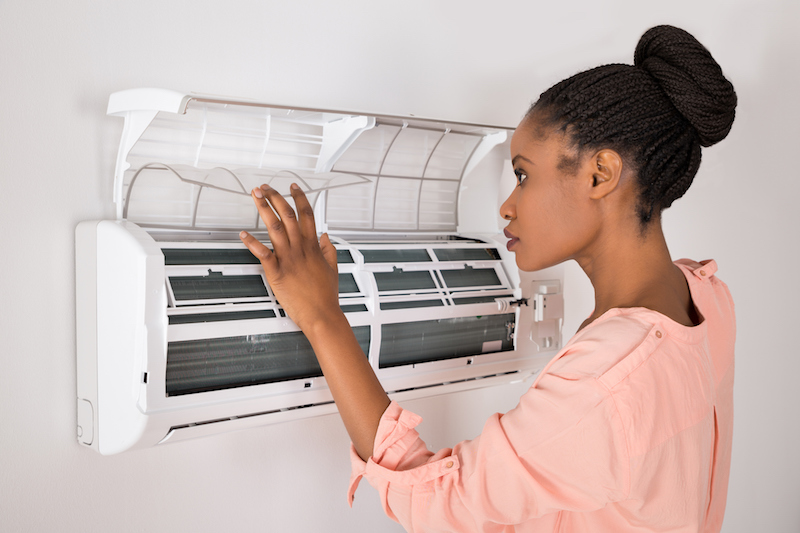
You shouldn’t be forced to give up comfort or empty your wallet to keep your residence at a pleasant setting during muggy weather.
But what is the ideal temperature, exactly? We go over advice from energy professionals so you can find the best temp for your family.
Here’s what we advise for the most energy-efficient setting for air conditioning in Manassas.
Recommended Thermostat Settings for Summer
Most people find placing the thermostat at 72-73 degrees is most comfortable. However, if there’s a sizeable difference between your interior and outside warmth, your electricity costs will be larger.
These are our recommendations based on the U.S. Department of Energy (DOE) and ENERGY STAR®.
While at home: 78 degrees. While that seems too high, there are ways you can keep your residence cool without having the air conditioning on frequently.
Keeping windows and curtains closed during the day keeps cold air where it belongs—within your home. Some window coverings, including honeycomb shades or plantation shutters, are made to deliver more insulation and improved energy efficiency.
If you have ceiling fans in your house, the DOE says you can raise thermostat temps about 4 degrees warmer without giving up comfort. That’s since they freshen with a windchill effect. Because they cool people, not rooms, shut them off when you exit a room.
If 78 degrees still seems too uncomfortable at first glance, try conducting a trial for approximately a week. Get started by increasing your setting to 78 degrees while you’re home. Then, gradually decrease it while using the advice above. You may be surprised at how cool you feel at a hotter temperature setting.
While away: 88 degrees. There’s no need to keep the air conditioner working all day while your house is unoccupied. Switching the setting 7–10 degrees hotter can save you an estimated 5–15% on your electricity bills, according to the DOE.
When you get home, don’t be tempted to set your thermostat below 78 to cool your house faster. This isn’t useful and often produces a higher electrical expense.
A programmable thermostat is a useful way to keep your settings under control, but it requires setting programs. If you don’t use programs, you run the risk of forgetting to raise the set temperature when you leave.
If you want a convenient remedy, consider installing a smart thermostat. This thermostat links with your phone, so it realizes when you’re at home and when you’re gone. Then it automatically changes temperature settings for the best savings. How much exactly? Typically $180 each year on heating and cooling, according to ENERGY STAR.
Another plus of using a smart thermostat? You can use your phone to watch and regulate temperature settings from just about anywhere.
While sleeping: Around 70 degrees. While ENERGY STAR recommends 82 degrees, that could be unbearable for the majority of families. The majority of people sleep better when their sleeping space is chilled, so that’s why the National Sleep Foundation recommends 60–67 degrees. But that may be too cool, depending on your pajama and blanket preference.
We recommend trying a comparable test over a week, moving your temp higher and gradually lowering it to pick the right temperature for your family. On cool nights, you might find keeping windows open at night and using a ceiling fan is a better solution than using the air conditioning.
More Methods to Conserve Energy During Hot Weather
There are other ways you can conserve money on utility bills throughout warm weather.
- Get an energy-efficient AC system. Central air conditioners only are effective for about 12–15 years and get less efficient as they age. An updated air conditioner can keep your residence more comfortable while keeping electricity bills small.
- Set annual air conditioner maintenance. Regular air conditioner maintenance keeps your unit operating like it should and could help it work more efficiently. It may also help prolong its life expectancy, since it helps technicians to uncover little issues before they cause a major meltdown.
- Replace air filters frequently. Use manufacturer instructions for changing your air filter. A dirty filter can cause your system to short cycle, or switch on and off too often, and raise your electrical.
- Inspect attic insulation levels. Just about 90% of homes in the U.S. don’t have adequate insulation, according to the Insulation Institute. Most southern climates require 13–14” of attic insulation, while northern climates require 16–18”.
- Have your ductwork examined. Ductwork that has loosened over time can seep cold air into your attic, walls or crawl space. This can lead to major comfort issues in your home, such as hot and cold spots.
- Seal openings, doors and windows. Keep muggy air in its place by sealing openings. You can also caulk or weather strip doors to seal more cold air indoors.
Save More Energy This Summer with Woody's Sudden Service
If you are looking to use less energy during warm weather, our Woody's Sudden Service pros can assist you. Get in touch with us at 703-278-2036 or contact us online for extra details about our energy-saving cooling products.
